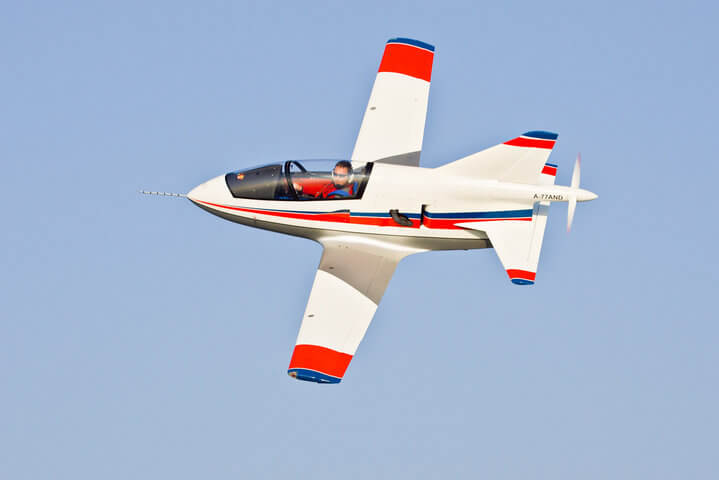The story of BD-5 is truly debatable in the aviation industry. Notably, Bede BD-5 holds several world records such as the lightest aircraft in the world, weighing only 162,7 kg, and also as the smallest in the world. Additionally, BD-5 is a popular air show performer.
On another hand, BD-5 is known for its numerous fatal crashes, which led to many professional pilots’ deaths. What truly hides behind the phenomenon of the BD-5?
Quick rise and end of Bede BD-5 production
In the late 1960s, the U.S. aircraft designer Jim Bede created the first-ever Bede BD-5, which belonged to the series of single-seat homebuilt aircraft. It has a small, streamlined fuselage with space under a canopy for a semi-reclined pilot and an engine in the middle of the fuselage. The BD-5 was introduced in the aviation market by Bede Aircraft Corporation in the early 1970s.
By the end of 1971, the company, run by Bede, had already taken over 4,300 orders of BD-5 kits, which made it one of the most popular general aircraft projects in modern history. BD-5 kit is a set of necessary equipment and plan, which are needed to build-up a single-seat plane. At the beginning of 1973, the primary design of BD-5 was complete, but engines remained the only part, which held up thousands of deliveries. The Bede company offered to ship the engine after the kit was sent. At the end of the same year, many clients received only unfinished kits and plans.
More than 5000 kits were delivered to the clients during the next 3-5 years, but once again, the BD-5 lacked suitable engines. The Bede company officially went bankrupt in 1979. At that point, the BD-5 project was dead.
Does the Bede BD-5 still steal the show?
Usually, the bankruptcy means the complete end of the company or its production, but not for BD-5. Although the project of Bede BD-5J was finished in 1979, the real fame of BD-5 came after it appeared in a James Bond film “Octopussy”, in 1983.
The remarkable aircraft plays a famous role in the opening sequence of the film. After the world’s premier of “Octopussy”, BD-5J was a well-liked for airshows and promotional purposes in the 1990s.
From the Hollywood fame to the phenomenon of fatal crashes
In total, a couple of hundred BD-5s were created and fifty of them remain airworthy nowadays. Through the years, BD-5 became more recognized for its fatal crashes, not for being the aircraft star of the James Bond movie.
The engine failure downed the BD-5J single-seater and killed a Flying Bulls pilot in 2013. Guido Gehrmann was heading from the airshow performance in Tyrol, Italy to Salzberg, Austria. Due to the engine failure, Gehrmann attempted the forced landing and crashed near Innsbruck, Austria.
In 2015, the engine of the BD-5 was on fire even before the fatal crash of the aircraft. The pilot, Howard Cox, was on the way to Shannon, Ireland, to take part in the Foynes Air Show the following day. Before the accident, Cox made a mayday call saying that he was having an engine failure and was on fire. Moments later, BD-5 crashed into a field near Waterford, Ireland, killing the pilot.
In 2019, BD-5 crashed again. John Lewis, the pilot, took off from the Camarillo Airport. Lewis planned to take a return flight to the same airport. A few moments after taking off, Lewis reported he had trouble gaining altitude. Just in a couple of seconds, the pilot crashed into a field of lettuce near Las Posas Road.
According to the Aviation Safety Institute, around 15 percent of all BD-5s flights ended up as fatal crashes, killing many professional pilots. Many BD-5s crashed due to engine failures. Seemingly, BD-5 engines are surrounded with mystery from the beginning of the project by Bede company.
